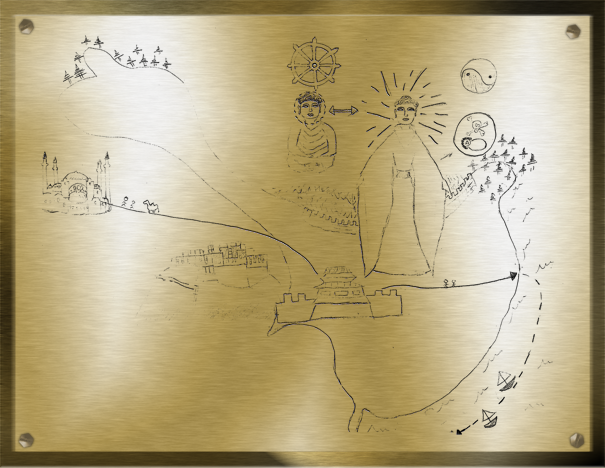| Time Period | 700 AD – Empress Wu |
| Geographical Region | China — Tang Dynasty |
| List of Symbols |
|
My golden plaque depicts the high Tang period around the year 700 AD. China was under the reign of the first and only female empress, Empress Wu. Empress Wu rose from the rank of a lowly concubine to the sole ruler of China. She founded the short lived Zhou dynasty, heavily supported Buddhism, and instigated many new government reforms. She can be identified on my plaque as the ruler by the radiating lines coming from above her head and by the large size of her image in relation to the other symbols. She is depicted wearing a long flowing gown in the style popular during the Tang dynasty.
To legitimize her right as ruler she claimed to be a reincarnation of the female goddess Heavenly Lady Pure and Radiant whose life and deeds were recorded in The Great Cloud Sutra (a minor Buddhist text). She was a great supporter of Buddhism and even went as far as placing her face on statues of bodhisattvas (the most famous of which is located at Longmen Cave). This is depicted on my plaque by the arrow between the Bodhisattva (located to the left of the empress) and Empress Wu pointing out that they both have the same face and hair styles. It is clear that the symbol to the left of the empress is a bodhisattva by the Buddhist wheel of life located directly above it. Precisely to the right of the wheel of life is the Daoist Ying-Yang symbol. Daoism and Buddhism were the two most prominent religions in 700AD China.
Empress Wu was known for her intelligence and ruthless desire for power. It is believed that she even killed her own baby girl to eliminate her top rival. On my plaque to the right of the empress, is a baby girl with a skull and crossbones to show the murder of her child.
In the background there is a enormous rough map of what 700AD China looked like. Along the northern boarder is the Great Wall of China with the Mongolian grasslands above it. The northeast and northwest have trees to depict the forests. The ocean defines the east coast and in the west is the Tibetan empire. I drew BuDaLaGong (Potala Palace) on top of a hill to depict the Tibetan empire and plateau. The large palace in the mid-west of China is the capital city, Chang’an. I drew it out of proportion to depict the importance and significance of the area. Since it is the only building inside the boarders of China, anyone looking at the plaque would be able to determine that this must be where the ruler of the country resides.
700AD was the high point of the Silk Road. The long bold line that runs east to west with tiny merchants and camels walking along it represents the Silk Road’s land route. The dotted line in the ocean by the boats illustrates part of the Silk Road’s water route to India and south Asia. On the far left I drew the Hagia Sophia to represent the western world and Constantinople. By having the Silk Road connect Constantinople and Chang’an it portrays that the capital of China was a cosmopolitan center. It also illustrates that the Tang dynasty was a time of agricultural and commercial prosperity, advancement of the arts, a high point in education and intellect, and that China was a flourishing advanced country.

KATELYN CROFT is a junior at the Eastman School of Music / University of Rochester where she is double majoring in Harp performance and Chinese Studies. In her spare time she enjoys reading, hiking, sewing, kayaking, doing Taekwondo, and traveling. More by Katelyn
